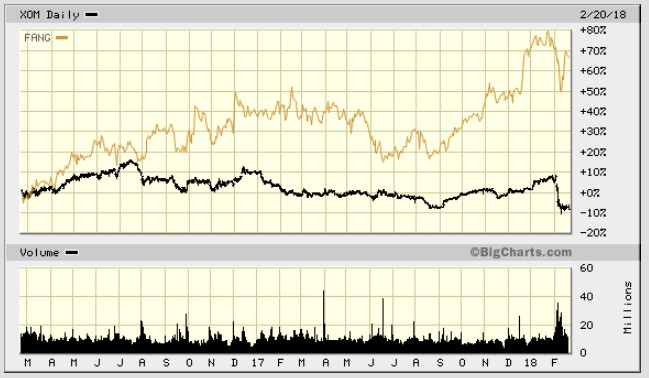The Big Oil Trap
It was so much easier for Big Oil 80 years ago.
When the geologists from Standard Oil of California (SOCAL), the precursor to Chevron, stood on a sandy dune near a small village called Dammam in Saudi Arabia during spring of 1938, life was good.
The company had just struck oil that March, and that soon would be followed up with a host of oil discoveries.

Like I said, life was good.
The same could be said for the rest of the world's biggest multinational oil companies, nicknamed the Seven Sisters.
After all, these seven companies absolutely dominated the oil industry at the time, controlling more than 85% of global oil reserves.
For investors, the Seven Sisters were among the safest stocks to own and were often referred to as orphan-and-widow stocks - companies that were known for their high-paying dividends and low risk.
This class is essentially the "set it and forget it" of stocks.
But oh, how the times have changed.
The downfall of the Seven Sisters took place as state-owned oil companies like Saudi Aramco took over. Now, these new seven sisters control a mind-numbing 90% of the petroleum reserves on the planet, as well as three-quarters of global crude production.
You can't help but wonder if there aren't better players out there today...
I'll show you one in just a moment.
Demand Dynamics
We've talked a lot about oil's rally over the last two years, ever since prices bottomed out in February of 2016.
And with OPEC and Russia committed to their output deal through the end of 2018 (although they'll revisit the agreement soon, it's clear all parties are on board), there's only one place that everyone expects production to increase.
The United States.
Of course, anyone who's followed the shale boom over the last decade could've seen that coming a mile away.
Between 2016 and 2020, OPEC expects the U.S. to contribute nearly 4 million barrels per day to non-OPEC liquids supply:

In fact, the oil cartel expects tight oil output in the U.S. and Canada to account for 8.8 million barrels per day by 2030.
Whether or not that prediction comes true, at the very least we know that U.S. tight oil production is going to play a heavy role in the world's crude supply growth in the foreseeable future.
And you might be surprised at who will come out on top for oil investors.
The Best Free Investment You'll Ever Make
Our analysts have traveled the world over, dedicated to finding the best and most profitable investments in the global energy markets. All you have to do to join our Energy and Capital investment community is sign up for the daily newsletter below.
We never spam! View our Privacy Policy You'll also get our free report, Two Stocks to Play The Coming U.S. Oil Export SurgeThe Big Oil Trap: Invest Smarter
Look, I know it's easy to see a household name like ExxonMobil and assume it's a good bet. Not only does it command a market cap of around $320 billion right now, but it's also got over $4 billion in its war chest currently.
That's the Big Oil trap.
So when Exxon missed its latest earnings and revenue estimates, it wasn't too surprising for my readers and me.
Don't get me wrong, dear reader; I understand the temptation. Exxon is a major player in one of the hottest oil plays in the world right now: the Permian Basin.
Right now, nearly 3 million barrels of oil is extracted from the Permian Basin on a daily basis, making up almost one-third of our total output.
So the fact that Exxon doubled its Permian acreage in 2017 and plans on boosting output in the play by 600,000 boepd makes that temptation to buy grow a little more.
That is, until you look at the rest of the field.
Take a closer look at Diamondback Energy (NASDAQ: FANG), for example.
Not only has it outperformed analyst expectations quarter after quarter for last two years, but it's also trading at a fraction of Exxon's market cap.
And it's one of several smaller players that will put Exxon's performance to shame. Since the last major bottom in oil in February of 2016, the returns haven't even been close:

Leave the day trading for someone else; this is the kind of buy-and-hold investment that still has enormous growth potential.
Over the next few weeks, we're going to shine the spotlight on a few other oil stocks worth a second look.
Stay tuned.
Until next time,

Keith Kohl
A trueinsider in the energy markets, Keith is one of few financialreporters to have visited the Alberta oil sands. His research has helpedthousands of investors capitalize from the rapidly changing face ofenergy. Keith connects with hundreds of thousands of readers as theManaging Editor of Energy & Capital as well as Investment Director of Angel Publishing's Energy Investor. For years, Keith has been providing in-depth coverage of the Bakken, theHaynesville Shale, and the Marcellus natural gas formations - all ahead of the mainstream media. For more onKeith, go to his editor's page.
 @KeithKohl1 on Twitter
@KeithKohl1 on Twitter